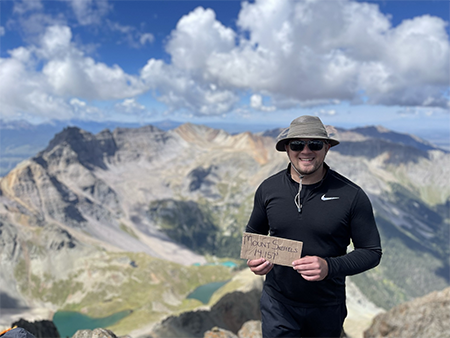
An Oklahoma researcher steers a project that will model elusive cloud processes in the Arctic’s atmospheric boundary layer
An old-fashioned telegram about University of Oklahoma atmospheric research scientist Andrew Dzambo might read like this:
Loves clouds. Speaks Python. Can operate airborne Doppler radar. Does forecasts. Works on his golf game. Crazy for travel. Competitive powerlifter. (Hint: Don’t ask him to arm wrestle.) Can bake his mother’s peanut blossom bread, a favorite the Cloud Physics Group he belongs to.
It’s “da-Zambo,” by the way. You pronounce the “D.”
A longer telegram would be required to explain the three-year project Dzambo has underway for the Atmospheric System Research (ASR) program at the U.S. Department of Energy (DOE).
In the fall of 2022, he began studying observations and will later help develop models on cloud life cycles in the Arctic.
Temperatures in the Arctic are rising four times faster than anywhere else in the world. Dzambo and a few modeling experts at the National Center for Atmospheric Research (NCAR) in Boulder, Colorado, want to fill in knowledge gaps on arctic sea ice, cloud properties, and aerosols.
Aerosols are tiny atmospheric particles—hybrids of liquids, solids, and gases—necessary for cloud formation and precipitation.

ARM and Observations
The ASR project’s observational data comes from DOE’s Atmospheric Radiation Measurement (ARM) user facility. ARM operates three fixed and three mobile atmospheric observatories in climate-critical regions of the world.
Dzambo is overseeing the project’s observational work. At NCAR, Kamal Kant Chandrakar will take the lead in the project’s mission to develop models.
Chandrakar and his team will use NCAR’s Cloud Model 1, which generates large eddy simulations of the lowest 1 to 2 kilometers (1 mile) of the atmosphere. To modify Model 1, they will leverage recent experiences with the superdroplet method, a large-scale, particles-based cloud microphysics scheme.
“I am very excited to see how these new observations ultimately improve the modeling work on their end,” says Dzambo.
Two Sets of Arctic Eyes
Dzambo is busy getting caught up with data from the two field campaigns from which the ASR project will draw.
One is the 2019─2020: Multidisciplinary Drifting Observatory for the Study of Arctic Climate (MOSAiC), to which ARM contributed remote-sensing that provided a rare look at the Arctic’s atmosphere. MOSAiC, an international expedition, mounted instruments on a German icebreaker that served as both a laboratory and hotel. Frozen onto an ice floe, the ship drifted for a year in the Central Arctic, collecting data and supporting instrumented camps on the ice around it.
NCAR’s first model case studies will come from MOSAiC.
The second field campaign is the 2019─2020 Cold-Air Outbreaks in the Marine Boundary Layer Experiment (COMBLE), in which ARM sited its main instrumentation near a fishing village at the edge of the Norwegian Sea. Northernmost Norway is an ideal location for observing the fate of arctic air masses sweeping over warm water. Worldwide, such conditions (called cold air outbreaks) generate large areas of low-level cloud coverage.
Dzambo and his ASR team will use these data, coupled with meteorological measurements, to create a mathematical simulation of boundary layer processes in the Arctic ─ one that is more complete than scientists have today.
In the Arctic and elsewhere, the boundary layer comprises the lowest 1 kilometer or so (0.6 miles) of the atmosphere. In this dynamic region, the most clouds form and the most weather occurs. This layer is a complex mix of gases, water, dust, and aerosols. The boundary layer is part of the troposphere, which extends as high as 20 kilometers (12.4 miles) in tropical regions, and as low as 8 kilometers (4.9 miles) in the Arctic.
Dzambo and his ASR team hypothesize that surface energy fluxes, along with the atmospheric state of the troposphere, control arctic cloud properties ─ even more so than aerosols.
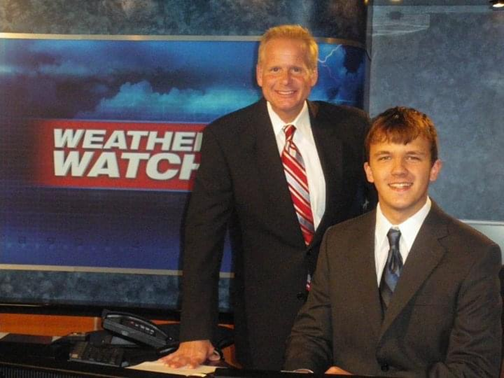
Trying Out TV
Dzambo grew up in Everson, Pennsylvania (pop. 768), a coke-and-coal mining town in southwestern Pennsylvania, an hour south of Pittsburgh by car. His mother, Cathe, was a bank branch manager who quit to help raise Dzambo and his brother Stephen (now a sales executive, who shares a love for numbers). Their father George, a long-time factory worker, retired in 2022.
Industry in the area waned during his childhood, but “the blue-collar work ethic and identity stayed,” says Dzambo.
In 1890, his great-great grandfather, a union activist, became the first Slovak citizen naturalized in Pennsylvania. Four years later, at age 78, he was beaten by a local sheriff during a coal strike and died of his injuries soon after.
“Up until my generation of Dzambo’s, very few of us went to college let alone pursued anything beyond a bachelor’s degree,” says the present-day Dzambo, who credits his parents for letting him pursue what he loves. “When I find something I love doing, I invest 100% of my energy and passion into it.”
Good at math and science early on, at Southmoreland High School Dzambo “took chemistry, physics, calculus, biology, and all the AP (Advanced Placement) courses they had. I loaded up.”
He was also (among many things) captain of the golf team, a Math 24 Challenge Program finalist, president of the Science Club, and captain of the school quiz team. Armed with a dazzling SAT score in math, Dzambo set off in 2009 to Pennsylvania State University (B.S., Meteorology, 2013) with the idea of being an on-air television meteorologist.
After his first year at Penn State, he interned with WTAE-TV, an ABC affiliate in Pittsburgh, where he worked with meteorologists Stephen Cropper, Demetrius Ivory, and Erin Kienzle.
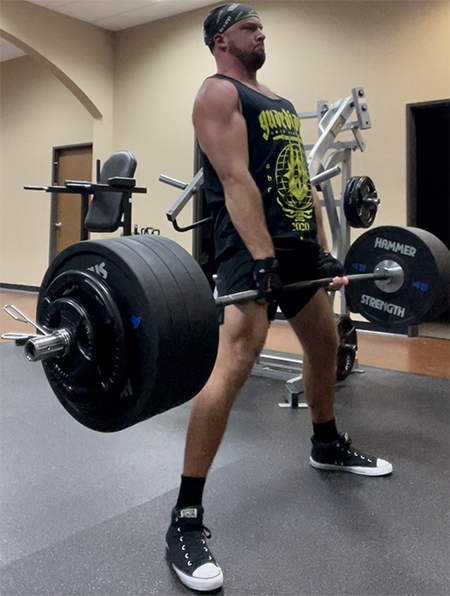
“I was, like, this is really cool,” including making on-air graphics, says Dzambo. “But something was missing. I wanted something that had more flexibility.”
Programming and Research
That something was research, a career path Dzambo started on by taking a meteorology programming class with Eugene Clothiaux, a professor whose interests include remote sensing of clouds and radiation.
After other programming classes outside his major, Dzambo got his first research experience with Jenni Evans, an expert in tropical meteorology and data science.
Before his final year of college, Dzambo did a research internship at Howard University with the help of Penn State professor Jose Fuentes, whose research includes the boundary layer and turbulence.
From there, Dzambo delved further into boundary layer meteorology, surface influences, and cloud formation. Increasingly, he understood how clouds remain the source of greatest uncertainties in models.
“Clouds are extremely important,” he says of this realization, which led him to develop a toolkit of research skills and interests “that ultimately worked into this ASR project.”
A Run at Writing
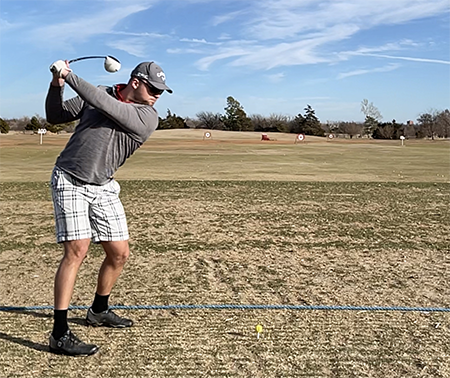
In the fall of 2011, during his senior year at Penn State, Dzambo acted on the fact that researchers must publish frequently. He tried his hand at science writing in the William Grundy Haven Student Paper Competition, open each year to students in the College of Earth and Mineral Sciences.
His paper on modeling tropical cyclones took first place among 30-plus applicants and seven finalists.
“Communication is arguably the important thing in science,” says Dzambo. “Without good communication, it’s difficult to convey important messages and ultimately the difference you seek to make on society.”
Years later, in 2020, he led a paper describing an online course on science literacy in the widely read Bulletin of the American Meteorological Society.
The message, says Dzambo, is that when students learn scientific facts about meteorology and climate, “they change their opinions on climate and climate change.”
That is, most of the students come to see how natural climate variability occurs over time; how human activity has changed the natural course of Earth’s climate evolution; and how human activity has accelerated climate change globally in ways not easily explained by natural cycles.
A Pause for Cirrus
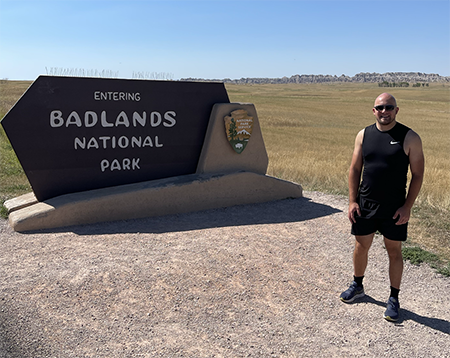
The next stop was the University of Oklahoma in Norman (M.S., Meteorology, 2015), where Dzambo worked with Dave Turner, a Clothiaux friend and colleague then at the National Severe Storms Laboratory.
Dzambo’s master’s thesis was on the climatology of cirrus clouds, the high-altitude, wispy type made entirely of ice.
He led a pair of papers that came out of that work, written in an eight-month interval after earning the degree and just before his PhD studies.
The first paper introduced algorithms designed to correct a modeling bias in which radiosonde data made relative humidity appear drier than it was.
“This was the key,” says Dzambo, “to convincing the reviewers that we had viable moisture measurements for the conclusions we came up with.”
The second paper, again with Turner as a coauthor, created a multi-decade climatology of relative humidity with respect to ice.
Working on a master’s degree acquainted Dzambo with radar observation, data set reanalysis, and further acquaintance with clouds and their complexities.
Turner encouraged him to move on to where he had earned a PhD in 2003: the University of Wisconsin-Madison (PhD, Atmospheric and Oceanic Sciences, 2020).
Africa Interlude
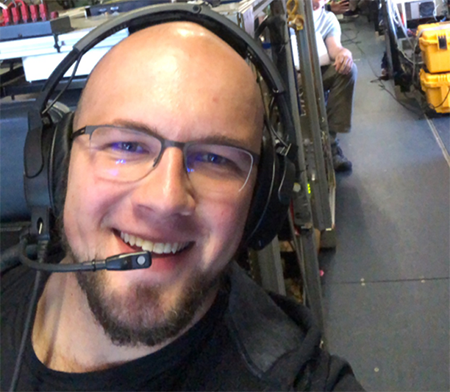
Before even arriving on campus, Dzambo reached out to Wisconsin-Madison professor Tristan L’Ecuyer, whose research team had many projects going on cloud and precipitation measurements from global satellites and field campaigns.
“It was an absolutely perfect fit,” says Dzambo.
He soon got involved in the 2016-2018 Observations of Aerosols above Clouds and their Interactions (ORACLES) field experiment, led by the University of Oklahoma’s Jens Redemann, then at NASA‘s Ames Research Center in California.
During the same time he worked with L’Ecuyer, Dzambo got to know Greg McFarquhar, who became his post-doctoral advisor and today directs the Cloud Physics Group Dzambo calls home.
ORACLES, funded by NASA, investigated the atmospheric influence of particles emitted from biomass burning on the continent. Over two summers and one fall, Dzambo operated a third-generation Advanced Precipitation and Cloud Radar (APR-3) aboard NASA’s P-3 aircraft.
During ORACLES flights, the APR-3 collected more than 10 million profiles of stratocumulus clouds over the southeast Atlantic Ocean off the coast of Southern Africa.
“I participated in at least half of the research flights,” says Dzambo, including those during all three of the campaign’s intensive operational periods.
Airborne Radar Data
Dzambo folded the ORACLES airborne radar data into a PhD dissertation, along with leading more studies in the peer-reviewed literature.
In one PhD-related 2019 paper, he used airborne radar data to document the structure of stratocumulus clouds off the coast of Africa, the frequency and intensity of their precipitation, and the atmospheric stability of the clouds.
“Communication is arguably the important thing in science. Without good communication, it’s difficult to convey important messages and ultimately the difference you seek to make on society.”
– Andrew Dzambo
Another study, in 2021, used airborne radar observations from ORACLES to expand scant observational data on marine cloud and precipitation processes in the region and to record the interplay between them.
The paper demonstrated a new joint cloud-precipitation retrieval algorithm Dzambo developed to combine data from two types of radar. The idea was to pinpoint sources of liquid water in warm clouds, a critical influence on solar radiation. Some of the water comes from cloud water and the rest from rainwater.
Dzambo created (and still curates) a cloud water path-rainwater path data product archived by NASA and used by modelers.
Months in Africa aside, he has enjoyed other field work, including a stint as a forecaster in the summer of 2022 in the Houston, Texas, area. That role was for the Experiment of Sea Breeze Convection, Aerosols, Precipitation and Environment (ESCAPE), funded by the National Science Foundation.
ESCAPE’s cloud-processes science mission was aligned with an ARM field campaign going on for a longer time in the same region: the TRacking Aerosols Convection interactions ExpeRiment (TRACER).
In February through April 2024, Dzambo will deploy to Kiruna, Sweden, as co-lead of the forecasting and nowcasting teams during the upcoming Cold Air Outbreak Experiment in the Sub-Arctic Region (CAESAR). The project, directed by the Earth Observing Laboratory at the National Center for Atmospheric Research in Colorado, will investigate cold-air outbreaks over the North Atlantic.
Digging Deeper
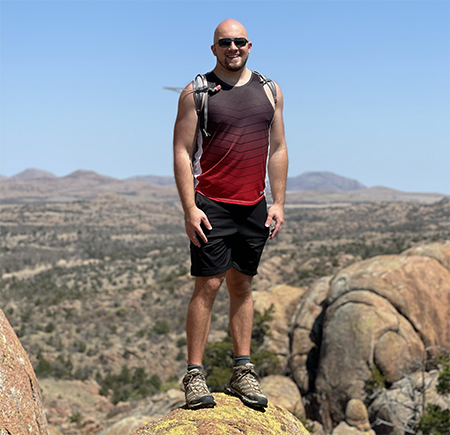
Dzambo defended his PhD dissertation two weeks before the pandemic widely curtailed in-person activities. Confronted by what he calls the shock of solitude, he began a stint as a postdoctoral researcher at Oklahoma (May 2020 to July 2022) and was promoted to Research Scientist in August 2022.
Working remotely for the university’s Cooperative Institute for Severe and High-Impact Weather Research Operations, Dzambo researched and wrote. But he also found time to dig deeper into his chief interests outside of science. The latest is studying behavior in global stock, bond, and currency markets.
One older standby is baking, which in part is an artifact of his Slovak family tradition, says Dzambo. “Few things stand the test of time better and longer than Bubba (Grandma) Dzambo’s bread recipe.”
Then there are other non-science interests: travel, golf, and powerlifting, an intense form of resistance training focused on the squat, bench press, and deadlift.
Dzambo started his weight training in 2017, initially to improve his golf game. These days, 35 pounds of muscle later, he still regularly runs through Heavy Athletics powerlifting routines and specialized workouts.
His overall personal bests in the three exercises add up to 1,175 pounds. That one-repetition total of the three exercises makes him a member of the sport’s 1,000-Pound Club.
Now powerlifting is a lifestyle for Dzambo and a platform for expanding the horizon of physical culture. When he travels, he often hikes. And he recently ran a half-marathon.
Add in a busy ASR project, says Dzambo, “and I’m genuinely happy.”
# # #Author: Corydon Ireland, Science Writer, Pacific Northwest National Laboratory
This work was supported by the U.S. Department of Energy’s Office of Science, through the Biological and Environmental Research program as part of the Atmospheric System Research program.

